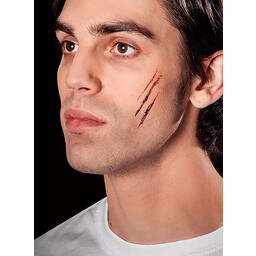Product description
Wound Scab is a high-quality special effects product that guarantees professional results when used correctly. Apply the material directly onto the skin and distribute it as desired. Use a coarse sponge to mimic scratches and imitate small cuts with the back of a knife or a thin brush. ABRASIONS: Take some Wound Scab with a coarse sponge and, with gentle pressure, pull the scab across prominent parts of the face, such as the nose, cheekbones, or chin. Repeat this process in parallel lines until the wound appears deep enough. Adding a bit of potting soil or bird sand can mimic dirt. FILLING WOUNDS: You can effectively fill deeper special FX wounds with Wound Scab. Apply it with a toothpick or fine brush into the recess of the wound. For cuts or punctures, extend the scab from the wound application onto the regular skin. This allows the cut to gradually fade out. MINOR CUTS: Use a spatula or the blunt edge of a knife to apply Wound Scab directly onto the skin. You can also create streaks and threads with a cotton swab soaked in fake blood.
Details:
Material: Aqua, Propylene Glycol, Hydroxyethylcellulose, Triethanolamine, ImidazolidinylUrea, Methylparaben, CI 16035, CI073015
12 months shelf life
Attention: Do not use Wound Crust near the eyes or directly in the eye! The blood can cause permanent stains on some fabrics and surfaces. Therefore, do not use it on carpets and upholstery. For children under 10 years, use only under adult supervision. If you are allergic to the listed ingredients, do not use the product.
Volume: 28,4 g
Shipment weight (g): 100 *
This item is produced in limited quantities only. This means that every piece is unique. Sizes & finish may vary lightly from piece to piece.
When packaging this item, we exclusively use 100% recycled plastic and recycled paper/cardboard from FSC certified forests. We reuse a large part of the material directly without the intervention of a recycling process.
Recycle the material by separating your waste:
1. Cardboard: separate or reuse your paper.
2. Plastic cushions, clothing bags and plastic tape: separate or reuse your plastic. If possible, pierce the cushions with a volume reduction needle.
3. Paper packaging for jewelry and small items: these have a plastic inner layer. Remove these, then separate your paper and plastic.
Read here about how we are committed to sustainability.







